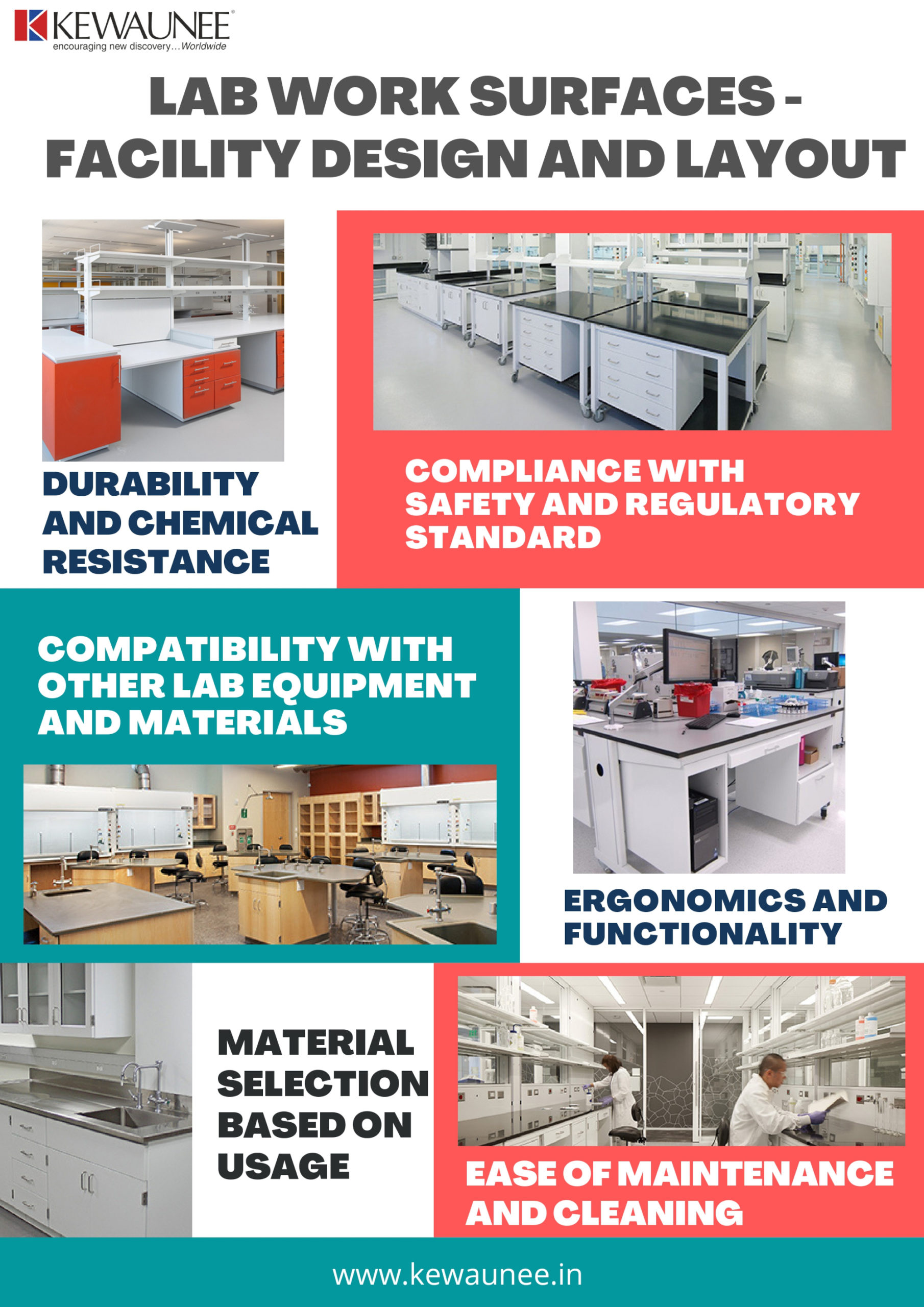Lab Work Surfaces – Facility Design and Layout
Lab work surfaces play a crucial role in the design and functionality of a laboratory. These surfaces are the foundation of any laboratory, providing a work area for researchers and scientists to carry out their experiments and analysis.
It’s essential to have high-quality lab work surfaces that are durable, chemical resistant, and easy to maintain. Inadequate lab work surfaces can lead to a lack of functionality, safety issues, and increased maintenance costs.
Types of lab work surfaces
There are different types of lab work surfaces available, including:
- Countertops
- bench tops
- table tops, and
- workstations.
These surfaces are used for various purposes, such as preparing samples, conducting experiments, and analyzing data.
Materials used
When choosing lab work surfaces, it’s essential to consider the type of materials used. Some of the most common materials used for lab work surfaces include:
- epoxy resin,
- stainless steel,
- phenolic resin,
- polypropylene, glass, and
- laminate.
Each material has its own unique properties and advantages, making them suitable for different types of laboratory environments and applications.
Considerations when designing lab work surfaces
When designing lab work surfaces, it’s important to consider the following factors:
- Durability and chemical resistance: Lab work surfaces must be able to withstand the harsh chemicals and materials used in a laboratory.
- Compliance with safety and regulatory standards: Lab work surfaces must comply with relevant safety and regulatory standards to ensure the safety of laboratory workers.
- Ease of maintenance and cleaning: Lab work surfaces must be easy to clean and maintain to keep the laboratory environment safe and hygienic.
- Ergonomics and functionality: Lab work surfaces must be designed to provide optimal ergonomics and functionality for laboratory workers.
- Compatibility with other lab equipment and materials: Lab work surfaces must be compatible with other lab equipment and materials used in the laboratory.
- Material selection based on usage and chemical resistance: The material used for lab work surfaces must be selected based on the intended usage and chemical resistance required.
Lab work surfaces & laboratory environment
High-quality lab work surfaces can have a positive impact on the laboratory environment, including:
- Improved functionality and efficiency: High-quality lab work surfaces can improve the functionality and efficiency of a laboratory.
- Enhanced safety and compliance: High-quality lab work surfaces can enhance safety and compliance in the laboratory.
- Extended lifespan and cost savings: High-quality lab work surfaces can extend the lifespan of laboratory equipment and save costs in the long run.
- Improved air quality and ventilation: High-quality lab work surfaces can improve air quality and ventilation in the laboratory.
- Enhanced ergonomics and comfort for lab workers: High-quality lab work surfaces can provide enhanced ergonomics and comfort for lab workers.
- Improved chemical resistance and durability: High-quality lab work surfaces can improve chemical resistance and durability, which is important to keep the laboratory safe and functional.
Choosing a reputable supplier
When choosing a supplier for lab work surfaces, it’s important to consider the following factors:
- Research and reputation: Research the supplier’s reputation and track record in the industry.
- Quality of products and customer service: Make sure the supplier’s products are of high quality and that they provide excellent customer service.
- Compliance with safety and regulatory standards: Ensure the supplier’s products comply with relevant safety and regulatory standards.
- Track record of successful installations and customer satisfaction: Check the supplier’s track record of successful installations and customer satisfaction.
- Material selection based on usage and chemical resistance: Make sure the supplier offers a range of materials to choose from that are suitable for different laboratory environments and applications.
Conclusion
In conclusion, lab work surfaces play a crucial role in the design and functionality of a laboratory. It’s essential to have high-quality lab work surfaces that are durable, chemical resistant, and easy to maintain.
Proper planning, design, and material selection when choosing lab work surfaces is crucial to ensure safety, compliance, and longevity. Laboratory managers and designers should prioritize the use of high-quality and suitable lab work surfaces in their laboratory spaces.
And always choose a reputable supplier that can provide quality products and customer service, and comply with safety and regulatory standards.
Comments are closed.











